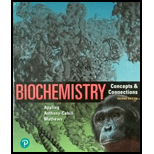
Concept explainers
(a)
Interpretation: The balanced equation for complete oxidation of ethanol should be written and the respiratory quotient should be calculated.
Concept introduction:
The oxidation is addition of oxygen, thus, if any species react with oxygen and it get added to the molecule of that species, it gets oxidized.
Respiratory quotient or RQ is defined as the ratio of volume of carbon dioxide to the volume of the oxygen consumed.
(a)
Explanation of Solution
The equation for complete oxidation of ethanol is as follows:
The RQ value is:
From the balanced chemical equation,
Hence, respiratory quotient of ethanol is
(b)
Interpretation: The balanced equation for complete oxidation of acetic acid should be written and the respiratory quotient should be calculated.
Concept introduction:
The oxidation is addition of oxygen, thus, if any species react with oxygen and it get added to the molecule of that species, it get oxidized.
Respiratory quotient or RQ is defined as the ratio of volume of carbon dioxide to the volume of the oxygen consumed.
(b)
Explanation of Solution
The equation for complete oxidation of acetic acid is:
The RQ value is:
From the balanced chemical equation,
Hence, respiratory quotient of acetic acid is
(c)
Interpretation: The balanced equation for complete oxidation of stearic acid should be written and the respiratory quotient should be calculated.
Concept introduction:
The oxidation is addition of oxygen, thus, if any species react with oxygen and it get added to the molecule of that species, it get oxidized.
Respiratory quotient or RQ is defined as the ratio of volume of carbon dioxide to the volume of the oxygen consumed.
(c)
Explanation of Solution
The equation for complete oxidation of stearic acid is:
The RQ value is:
From the balanced chemical equation,
Hence, respiratory quotient of stearic acid is
(d)
Interpretation: The balanced equation for complete oxidation of oleic acid should be written and the respiratory quotient should be calculated.
Concept introduction:
The oxidation is addition of oxygen, thus, if any species react with oxygen and it get added to the molecule of that species, it get oxidized.
Respiratory quotient or RQ is defined as the ratio of volume of carbon dioxide to the volume of the oxygen consumed.
(d)
Explanation of Solution
The equation for complete oxidation of oleic acid is:
The RQ value is:
From the balanced chemical equation,
Hence, respiratory quotient of oleic acid is
(e)
Interpretation: The balanced equation for complete oxidation of linoleic acid should be written and the respiratory quotient should be calculated.
Concept introduction:
The oxidation is addition of oxygen, thus, if any species react with oxygen and it get added to the molecule of that species, it get oxidized.
Respiratory quotient or RQ is defined as the ratio of volume of carbon dioxide to the volume of the oxygen consumed.
(e)
Explanation of Solution
The equation for complete oxidation of linoleic acid is:
The RQ value is:
From the balanced chemical equation,
Hence, respiratory coefficient of linoleic acid is
Want to see more full solutions like this?
Chapter 11 Solutions
Biochemistry: Concepts and Connections (2nd Edition)
- Which type of enzyme catalyses the following reaction? oxidoreductase, transferase, hydrolase, lyase, isomerase, or ligase.arrow_forward+NH+ CO₂ +P H₂N + ATP H₂N NH₂ +ADParrow_forwardWhich type of enzyme catalyses the following reaction? oxidoreductase, transferase, hydrolase, lyase, isomerase, or ligase.arrow_forward
- Which features of the curves in Figure 30-2 indicates that the enzyme is not consumed in the overall reaction? ES is lower in energy that E + S and EP is lower in energy than E + P. What does this tell you about the stability of ES versus E + S and EP versus E + P.arrow_forwardLooking at the figure 30-5 what intermolecular forces are present between the substrate and the enzyme and the substrate and cofactors.arrow_forwardprovide short answers to the followings Urgent!arrow_forward
- Pyruvate is accepted into the TCA cycle by a “feeder” reaction using the pyruvatedehydrogenase complex, resulting in acetyl-CoA and CO2. Provide a full mechanismfor this reaction utilizing the TPP cofactor. Include the roles of all cofactors.arrow_forwardB- Vitamins are converted readily into important metabolic cofactors. Deficiency inany one of them has serious side effects. a. The disease beriberi results from a vitamin B 1 (Thiamine) deficiency and ischaracterized by cardiac and neurological symptoms. One key diagnostic forthis disease is an increased level of pyruvate and α-ketoglutarate in thebloodstream. How does this vitamin deficiency lead to increased serumlevels of these factors? b. What would you expect the effect on the TCA intermediates for a patientsuffering from vitamin B 5 deficiency? c. What would you expect the effect on the TCA intermediates for a patientsuffering from vitamin B 2 /B 3 deficiency?arrow_forwardDraw the Krebs Cycle and show the entry points for the amino acids Alanine,Glutamic Acid, Asparagine, and Valine into the Krebs Cycle - (Draw the Mechanism). How many rounds of Krebs will be required to waste all Carbons of Glutamic Acidas CO2?arrow_forward
 BiochemistryBiochemistryISBN:9781319114671Author:Lubert Stryer, Jeremy M. Berg, John L. Tymoczko, Gregory J. Gatto Jr.Publisher:W. H. Freeman
BiochemistryBiochemistryISBN:9781319114671Author:Lubert Stryer, Jeremy M. Berg, John L. Tymoczko, Gregory J. Gatto Jr.Publisher:W. H. Freeman Lehninger Principles of BiochemistryBiochemistryISBN:9781464126116Author:David L. Nelson, Michael M. CoxPublisher:W. H. Freeman
Lehninger Principles of BiochemistryBiochemistryISBN:9781464126116Author:David L. Nelson, Michael M. CoxPublisher:W. H. Freeman Fundamentals of Biochemistry: Life at the Molecul...BiochemistryISBN:9781118918401Author:Donald Voet, Judith G. Voet, Charlotte W. PrattPublisher:WILEY
Fundamentals of Biochemistry: Life at the Molecul...BiochemistryISBN:9781118918401Author:Donald Voet, Judith G. Voet, Charlotte W. PrattPublisher:WILEY BiochemistryBiochemistryISBN:9781305961135Author:Mary K. Campbell, Shawn O. Farrell, Owen M. McDougalPublisher:Cengage Learning
BiochemistryBiochemistryISBN:9781305961135Author:Mary K. Campbell, Shawn O. Farrell, Owen M. McDougalPublisher:Cengage Learning BiochemistryBiochemistryISBN:9781305577206Author:Reginald H. Garrett, Charles M. GrishamPublisher:Cengage Learning
BiochemistryBiochemistryISBN:9781305577206Author:Reginald H. Garrett, Charles M. GrishamPublisher:Cengage Learning Fundamentals of General, Organic, and Biological ...BiochemistryISBN:9780134015187Author:John E. McMurry, David S. Ballantine, Carl A. Hoeger, Virginia E. PetersonPublisher:PEARSON
Fundamentals of General, Organic, and Biological ...BiochemistryISBN:9780134015187Author:John E. McMurry, David S. Ballantine, Carl A. Hoeger, Virginia E. PetersonPublisher:PEARSON





